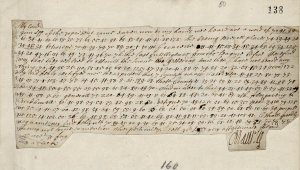Eine verschlüsselte Nachricht aus England gibt Rätsel auf. Gelingt es einem Leser, sie zu knacken? Die Chancen stehen vergleichsweise gut.
“Can you crack the code?”, fragt ein Autor auf einer Web-Seite des Britischen Nationalarchivs. Die Frage bezieht sich auf eine verschlüsselte Nachricht aus dem Jahr 1645, über die auf der besagten Seite leider keine weiteren Informationen gegeben werden. Hier ist die Nachricht:
Wer sich ein bisschen auskennt in der Verschlüsselungsgeschichte, erkennt sofort, dass hier ein Nomenklator verwendet wurde. Ein Nomenklator ist ein Verschlüsselungsverfahren, das für jeden Buchstaben des Alphabets sowie für wichtige Wörter je eine Zahl (oder eine Buchstabengruppe) vorsieht. Ein einfaches Beispiel:
A=1, B=2, C=3, D=4, …, Z=26, HUND=99, KATZE=123, MAUS=180
Der Ausdruck HUND KATZE UND MAUS verschlüsselt sich damit in 99, 123, 21, 14, 4, 180.
In der obigen verschlüsselten Nachricht kommen hauptsächlich zweistellige Zahlen vor. Vermutlich steht jede davon für einen Buchstaben oder ein ganzes Wort. Um eine Häufigkeitsanalyse zu erschweren, kann der Verschlüssler bei manchen Nomenklatoren zwischen mehreren Zahlen für denselben Buchstaben (zum Beispiel für das E) wählen.
Nomenklatoren waren ab dem 14. Jahrhundert in Gebrauch. Im 19. Jahrhundert erreichten sie die Größe von ganzen Büchern (man spricht dann allerdings nicht mehr von einem Nomenklator, sondern von einem Codebuch). Nomenklatoren und Codebücher waren vermutlich die meistverwendete Form des Verschlüsselns der Vor-Computer-Zeit überhaupt. Ab etwa 1800 erreichte diese Technik eine Qualität, bei der auch heutige Codeknacker oft passen müssen. Ungelöste Codebuch- bzw. Nomenklator-Nachrichten habe ich in Klausis Krypto Kolumne schon öfter vorgestellt:
Meine Leser haben zwar schon so manche verschlüsselte Nachricht gelöst, doch bei Nomenklator-Kryptogrammen konnte ich bisher noch keinen Erfolg vermelden. Die Nachricht, um die es heute geht, ist allerdings deutlich älter als alle bisher vorgestellten Nomenklator-Nachrichten und verwendet nur relativ wenige Zahlen. Sie könnte also durchaus zu knacken sein. Vielleicht hat ein Leser Lust, sich daran zu versuchen. Beim Britischen Nationalarchiv dürfte man sich gegebenenfalls freuen.
Follow @KlausSchmeh
Zum weiterlesen: Der Mann mit der Eisernen Maske: Wie ein Kryptologe das Rätsel (nicht) löste




Kommentare (17)